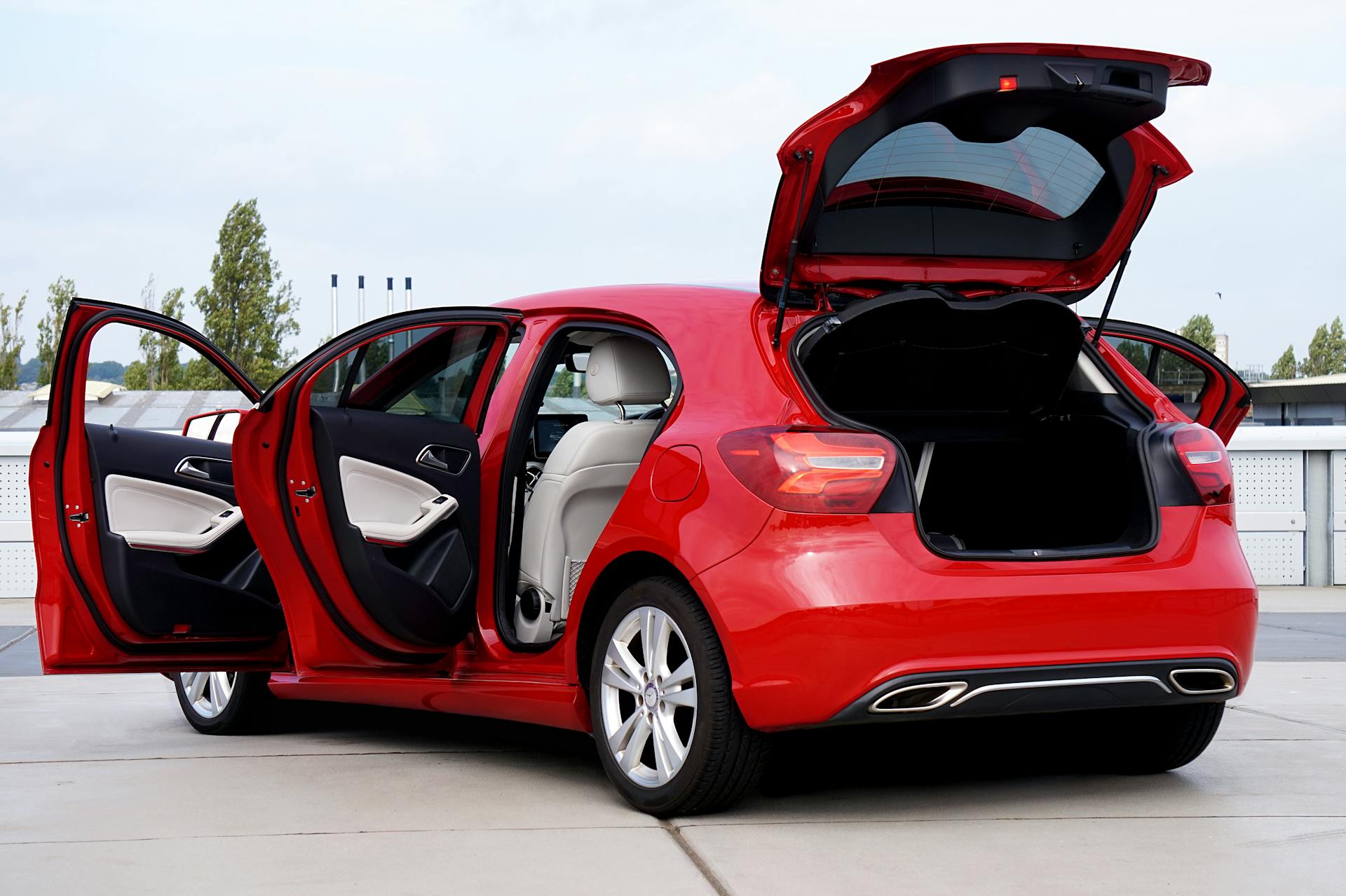
Power and free conveyor systems are a game-changer for efficient manufacturing. They allow for flexible production lines that can be easily reconfigured to accommodate changing product demands.
A power and free conveyor system can support up to 500 pounds per foot, making it ideal for heavy-duty manufacturing applications.
By using a power and free conveyor system, manufacturers can reduce labor costs and improve productivity. In fact, some manufacturers have reported a 20% increase in productivity after implementing a power and free conveyor system.
These systems are also highly customizable, allowing manufacturers to tailor the design to their specific needs.
What is a Power and Free Conveyor System?
A Power and Free Conveyor System is a type of overhead conveyor that's perfect for transporting parts along an assembly line. It allows products to buffer along the conveyor path, giving you the flexibility to stop and start individual loads as needed.
These systems are incredibly versatile, making them ideal for demanding industrial environments. They can handle loads ranging from 5 pounds to 20,000 pounds.
One of the key benefits of Power and Free Conveyors is their ability to stop individual loads without stopping the entire production line. This is a huge advantage over basic continuously moving overhead monorail conveyor systems.
Here are some of the key features of Power and Free Conveyors:
- Variable chain speeds
- High-speed indexing
- On-line storage
- Adaptability to changes in elevation
Power and Free Conveyors are designed to maximize your production capacity, and they're easy to maintain. They're the workhorse of the overhead conveyor product family, and for good reason.
Key Features and Benefits
Power and free conveyor systems offer a range of key features and benefits that make them a popular choice for many industries.
One of the main advantages is the ability to start and stop any load at virtually any location along the line, allowing for efficient and flexible production processes.
This flexibility means that individual conveyor loads can accumulate together and then be separated again in a controlled manner, enabling seamless integration with other production systems.
Power and free conveyors can include horizontal turns, vertical turns, and switches to send trolleys in different directions, making them highly adaptable to various production needs.
Many power and free conveyors feature two or more chains pulling the free trolleys around the system, allowing for a smooth and efficient transfer of loads.
In production areas, the chain may move slowly on a "production speed chain", and then the free trolley can transition to a high-speed chain for quick delivery to required areas.
This dual-chain system enables power and free conveyors to operate at different speeds, depending on the specific needs of the production process.
The ability to engage and disengage loads with the moving chain is a key feature of power and free conveyor systems, making them highly versatile and efficient.
Inverted power and free conveyors, which are mounted to the factory floor, offer an alternative to traditional overhead conveyor systems, providing even more flexibility and adaptability.
Types and Configurations
Power and free conveyor systems come in various configurations to suit different needs. There are six main types to consider: I-Beam Power and Free, Enclosed Track P&F, Inverted I-beam Power Free, Inverted enclosed track, Over-Under, and Tandem.
Each type offers unique benefits, but some are more suitable for specific industries or applications. The choice of configuration depends on the specific requirements of the production line.
The P&F380 Power & Free overhead conveyor system is a popular option, featuring two CALDAN straight profiles. In the upper "Power" profile, a cardan chain is powered by one or more drive units.
Here are the six main types of power and free conveyor systems:
- I-Beam Power and Free
- Enclosed Track P&F
- Inverted I-beam Power Free
- Inverted enclosed track
- Over-Under
- Tandem
The P&F380 can handle loads in up to 30° rise and fall sections, thanks to a unique link between the chain carriers and trolley pawls. This flexibility makes it suitable for a wide range of applications.
Advantages and Cost
Power and free conveyor systems are a popular choice for industries that require high volume, durability, and reliability. They generally have far fewer motors and moving parts than other overhead conveyor technologies, which reduces the risk of mechanical failure.
One of the key advantages of power and free conveyor systems is their flexibility. Simple pneumatic devices can be easily relocated along the line to stop and release carriers as needed. This allows for easy adjustments to be made if the customer's needs change.
The cost of power and free conveyor systems can be a significant investment, but they offer long-term benefits. The systems are designed to be durable and require less maintenance than other conveyor types. Here are some key benefits to consider:
- Exceptional flexibility in moving items through your facility
- Asynchronous movement allows for stopping and starting loads independently
- Integration of several tracks with merges and diverts
- Sharp turns and elevation changes to maximize facility space and storage
- Ability to run inverted with the load above the track if needed
Advantages and Cost
Power and Free conveyor systems offer numerous advantages, including high volume, durability, and reliability. They typically have far fewer motors and moving parts compared to other overhead conveyor technologies.
One of the key benefits of Power and Free conveyors is their simplicity. Electrical systems for these conveyors are often much simpler than those for friction conveyors or electrified monorail systems.
Pneumatic devices, such as air cylinders, can be easily relocated along the line to stop and release carriers as needed.
The "Dog-Magic" system, which allows trolleys to accumulate and disengage, provides a level of mechanical intelligence that's unmatched by many other conveyor types.
Power and Free conveyor systems are often the first choice for industries like the automotive industry, where high volume, durability, and reliability are crucial.
However, the cost of Power and Free conveyors can be higher than some other types of conveyors, such as hand push or monorail systems. But when compared to other overhead style conveyors that offer similar functionality, Power and Free conveyors are often the most affordable option.
According to various sources, Power and Free conveyors typically have 20-30% lower total installed cost compared to Electrified Monorail Systems (EMS). They also have far fewer motors and controls compared to Friction drive systems.
Here's a rough estimate of the cost difference between Power and Free conveyors and other types of conveyors:
Keep in mind that the actual cost will depend on various factors, including the specific application and system requirements.
Parts Storage
Parts Storage can be a game-changer for efficiency and productivity, especially when it comes to power and free conveyors. These systems allow you to hold items stationary in a buffering area as more come up the line behind them.
With power and free's compact turn radius and minimal 8" center-to-center loading, you can create a high density storage system that maximizes space and keeps production moving smoothly.
Specialized Applications
Power and free conveyor systems are incredibly versatile, making them a great choice for a variety of specialized applications.
In harsh environments, such as paint ovens and above dip tanks, power and free conveyors can be used with special shrouding and carrier design to prevent drips from landing on the product. This is especially important in food-safe environments, where conveyors like Ultimation and Webb's overhead conveyor systems can be used with H1 category food safe lubricants.
Power and free conveyors are also perfect for paint and finishing lines, where they can transport parts through curing ovens and wash areas while providing superior flexibility in how you set up your finishing lines. They can even divert and merge multiple tracks, allowing you to sort products among multiple paint lines that then merge to go through a single curing oven.
Here's a quick rundown of the different overhead conveyor categories, including their relative cost and installation orientation:
Special Environments
In harsh environments, Power and Free Conveyors are a great option. They're commonly used in paint ovens, above dip tanks, and throughout paint pre-treatment facilities.
To prevent drips from the chain from landing on the product, special shrouding and carrier design can be used. This is especially important in areas where cleanliness is crucial.
For food-safe conveyor systems, Ultimation and Webb's overhead conveyor systems can be used. These systems require the use of H1 category food-safe lubricants.
Power and Free Conveyors are a good choice for harsh environments, but they come with a higher price tag. They're categorized as $$$ in the cost table.
Here's a breakdown of the different types of overhead conveyor systems and their relative costs:
Power and Free Conveyors can be used in a variety of harsh environments, including paint ovens and dip tanks. Special design features can be added to prevent drips from the chain from landing on the product.
Paint Lines
Paint Lines are a crucial part of many manufacturing processes, and some conveyor styles are better suited for them than others.
Power and free conveyor systems are particularly well-suited for paint lines because they can transport parts through curing ovens and wash areas with ease.
This flexibility is key when setting up finishing lines, as it allows for the diversion and merging of multiple tracks.
For example, you can sort products among three paint lines, which then merge to go through a single curing oven.
System Overview and Components
Power and free conveyor systems are a type of material handling solution that can move products of various sizes and shapes throughout a facility.
These systems offer one of the most versatile and cost-effective means to move product, with capabilities such as multiple lane selectivity, product carriers stopping at automated loading, unloading or processing operations, and accumulation of product carriers to minimize delivery delays.
Available in three-, four-, and six-inch sizes, these systems can effectively and efficiently handle load requirements from the smallest part to several thousand pounds.
ASI engineers work to enhance this material handling choice to maximize facility's product quality and plant uptime.
Power and free conveyor systems have two tracks, with one track located above the other, and a powered chain track above an unpowered track with free, independently controlled trolleys.
The powered track has a rivetless conveyor chain attached, while the second track is for attaching loads via load bars and trolleys.
Pusher dogs, small mechanical devices, are used to push the free trolleys along the conveyor track, allowing them to move at the same speed as the power chain.
These systems can integrate multiple conveyor lines with diverts and merges for sortation and accumulation, and come in two standard carrying capacities of 220 or 440 pounds per trolley.
Frequently Asked Questions
What is a free conveyor?
A power and free conveyor is a versatile system used to transport parts along an assembly line, allowing them to stop and start automatically as needed. It enables efficient buffering and transportation of products between processes.
Sources
- https://www.ultimationinc.com/products-conveyor-systems/power-and-free-conveyors/
- https://railtechniek.com/blog/how-does-power-and-free-overhead-conveyor-work
- https://www.asi.com/power-free-conveyors/
- https://www.cisco-eagle.com/category/9901/power-and-free-overhead-conveyor
- https://caldan.dk/pf380-power-free-overhead-conveyor/
Featured Images: pexels.com


